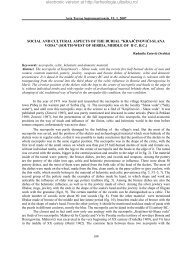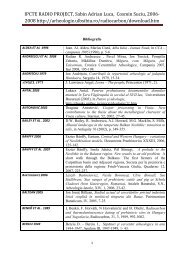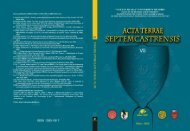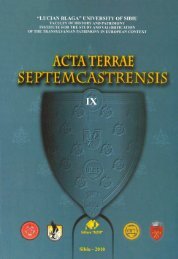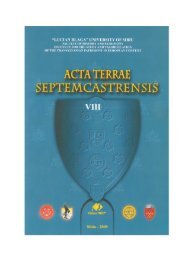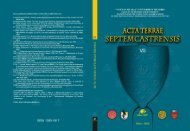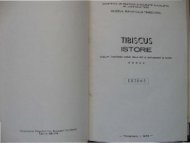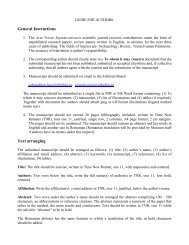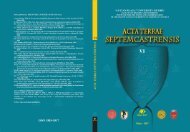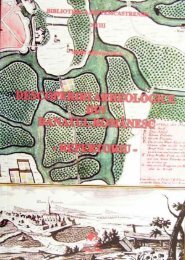acta terrae septemcastrensis
acta terrae septemcastrensis
acta terrae septemcastrensis
You also want an ePaper? Increase the reach of your titles
YUMPU automatically turns print PDFs into web optimized ePapers that Google loves.
Acta Terrae Septemcastrensis, IX, 2010Editorial board:Editor:Sabin Adrian LUCA („Lucian Blaga” University of Sibiu; BrukenthalNational Museum, Sibiu; Romania)Members:Ioan-Aurel POP (Correspondent Member of the Romanian Academy)Dumitru PROTASE (Honorary member of Romanian Academy)Janusz K. KOZŁOWSKI (Member of Poland Academy)Martin WHITE (Sussex University, Brighton, United Kingdom)Krum BACVAROV (Institute of Archaeology and Museum at theBulgarian Academy of Sciences, Bulgaria)Zeno-Karl PINTER („Lucian Blaga” University of Sibiu, Romania)Marin CÂRCIUMARU („Valahia” University of Târgovişte, Romania)Nicolae URSULESCU („Al. I. Cuza” University of Iaşi, Romania)Gheorghe LAZAROVICI („Eftimie Murgu” University of Reşiţa,Romania)Secretary:Cosmin Ioan SUCIU („Lucian Blaga” University of Sibiu, Romania)ISSN 1583-1817Contact adress: „Lucian Blaga” University of Sibiu, Faculty of Historyand Patrimony, Institute for the Study and Valorification of theTransylvanian Patrimony in European context, B-dul Victoriei Nr. 5-7,550024 Sibiu, România; tel. / fax. 0269 / 214468; 0745 / 366606; e-mail:sabinadrian.luca@ulbsibiu.ro, ins.arheologie@ulbsibiu.ro; web:http://arheologie.ulbsibiu.ro.4
Acta Terrae Septemcastrensis, IX, 2010proved to be quite difficult. The main reason for this is that it was the first time Iwas confronted with the translation of scientific articles which, in order to avoidconfusion and misunderstandings, required the use and knowledge of exact andprecise scientific terms from the field of archaeology. During my work, I useddictionaries such as “Concise Dictionary of Archaeology”, “Longman Dictionaryof English Language and Culture”; among them there were also several usefulonline dictionaries, such as YourDictionary.com, Dictionary.com, bab.La andEverest.The next step involved finding a modality through which the original scannedand modified document and the translated Word Document version could becombined in an attractive and easy-to-read way. Therefore, Corel Draw X3 provedto be the most suitable to fulfill the above-mentioned targets. It enabled me toinsert the scanned image in an A4 page, adjust the paper width from 210 mm to410 mm, place the scanned image on the left side of the Corel page and startadding new pages in order to comprise the entire article. The translated fragmentswere then taken from the Word document and placed next to the originalparagraphs, on the right side of each Corel page. It is important to mention that textcharacteristics such as Font (font, font style, size, font colour), Paragraph (i.e., linespacing) and page layout, must coincide both in the original and translated article.The first page of the future document is extremely important, since it presentsthe following: the scanned cover of the journal on the left side of the Corel page,brief information about the project itself (theme of the project - Neolithic andCopper Age signs, name of translator, the web page link of F-MU.S.EU.M.),general information about the translated article (article title in English, name ofauthor, name, number and year of journal, the article’s number of pages) or excerpt(book title, excerpt title, author of book, year and place of publication, publisher,pages on which the excerpt can be found), an abstract and the marks of the F-MU.S.EU.M. Project on the right side of the page.Lastly, the created Corel Draw X3 document was exported into a final PDFdocument which was improved by several actions: OCR recognition (select fromthe toolbar of the Adobe document: Document - OCR Text Recognition -Recognize Text Using OCR - All pages - Edit - Primary OCR Language - selectRomanian or Hungarian diacritics) and modification of the document properties(select from the toolbar of the Adobe document: File - Properties - Description: weadd the title and author of article, the subject of the project - Neolithic and CopperAge signs - and the keywords of the article).As a result, I translated the following articles: Ion Aldea - ,,Altarul” magicoritualdescoperit în aşezarea neolitică de la Ghirbom (com. Berghin, jud. Alba);Dumitru Berciu -Contribuţii la problemele neoliticului în România în luminanoilor cercetări (pp. 507-509: Problema plasticii culturii Boian si descoperirile dela Tangîru); Vasile Chirica - Amuleta-pandantiv de la Mitoc, jud. Botoşani andDatarea prin C 14 a unor locuiri gravettiene de la Mitoc-Malul Galben (com. Mitoc,jud. Botoşani); Vladimir Dumitrescu - Inscripţiuni preistorice în România?;Gruia Fazecaş - O tăbliţă de lut de la Suplacu de Barcău; Iuliu Paul - Cultura116
Acta Terrae Septemcastrensis, IX, 2010Petreşti (pp. 110-115); Gheorghe Lazarovici - Arhitectura neoliticului şi epociicuprului din România (pp. 198-207: Groapa rituală sau mormântul de la Tărtăria)and Despre simbolistica focului în neolitic (unpublished article); Sabin AdrianLuca, Ion Dragomir - Date cu privire la o statuetă inedită de la Liubcova-Orniţa(jud. Caraş-Severin); Anton Niţu - Despre semnificaţia motivului pictural în formăde ,,casă” de la Turdaş; Márton Roska - Erdély Régészeti Repertóriuma I. Őskor(pp. 7-15: Tordos, 806-817); Nicolae Ursulescu - Dovezi ale unei simbolistici anumerelor în cultura Precucuteni; Nicolae Ursulescu et alii - Noi date privindcomplexele de cult din cultura Precucuteni; Nicolae Vlassa - Probleme alecronologiei neoliticului mijlociu în lumina stratigrafiei aşezării de la Tărtăria,Contribuţii la problema racordării cronologiei relative a neoliticului Transilvanieila cronologia absolută a Orientului Apropiat, Noi contribuţii la problemainfluenţelor orientale în neoliticul Transilvaniei and ,,Căsuţele de cult de la Tudaş”.In addition to this, I also reviewed several English articles - including the oneswritten by Romanian authors from the ”Signs and Symbols from Danube Neolithicand Eneolithic” volume - which I completed with an abstract and prepared for theF-MU.S.EU.M. website in the same way and style as the others: Radian-RomusAndreescu - The sign: typology, context, meaning; Lazarovici Cornelia-Magda -Clay breads and tablets with signs and symbols; Lazarovici Gheorghe - Are theTărtăria tablets an ”enigma”?; Attila László - Some aspects of the Tărtăria issue;Luca Sabin Adrian - A new special discovery from Turdaş; Luca et alii - Incisedamulet from Turdaş-Luncă archaeological excavation; Nicolae Ursulescu, FelixAdrian Tencariu - Symbolic signs on the ceramics of the Chalcolithic settlementfrom Isaiia (Iaşi county, Romania).Future projectsWhile being at the ”Eötvös Lóránd” University of Budapest, as an Erasmusstudent during the 2009-2010 academic year, I intend to continue the process oftranslations regarding the theme of Neo-Eneolithic signs, but this time focusing onHungarian articles and books. Starting from the bibliography of Marco Merlini’sPhD thesis, I have already created a preliminary bibliographical list of articles to betranslated:Kalicz, Koós 2000 - Kalicz N., Koós J. S., Újkőkori arcos edények a Kárpátmedenceészakkeleti részéből. In: A Hermann Ottó Múzeum Évkönyve 39 (2000),15-44.Kàrolyi 1992 - Kàrolyi M., A korai rézkor emlékei Vas megyében,Szombathely (1992).Kutzián 1944 - Kutzián I., A Körös-kultúra, Dissertationes Pannonicae, Ser. II,No. 23, Budapest (1944) (published Budapest 1947).Orosz 1908 - Orosz E., Újabban fölfedezett erdélyi őstelepek. In: ErdélyiMúzeum, Cluj, 25 (1908), 259.Reinecke 1898 - Reinecke P., A tordosi őstelep agyagműveiről. In:Archaeologiai Értesítő, 18 (1898), 94-103.117
Acta Terrae Septemcastrensis, IX, 2010Reinecke 1898 - Reinecke P., Tordos és Trója. In: Archaeologiai Értesítő, 19(1899), 115-123.Torma 1879 - Torma Zs., Neolith kőkorszakbeli telepek Hunyad-megyében. In:Erdélyi Múzeum, Cluj (1879): 129-155, 190-211.Torma 1880 - Torma Zs., A nándori barlangcsoportozat. In: Erdélyi Múzeum,Cluj (1880), 153-171, 206-209.Torma 1882 - Torma Zs., Hunyad vármegye őskori történelméhez. In: AHunyadmegyei Történelmi és Régészeti Társulat Évkönyve, Deva (1882), 5-51.Torma 1902 - Torma Zs., A tordosi őstelep. In: G. Téglás (ed.),Hunyadvármegye földjének története az őskortól a honfoglalásig, Budapest (1902),23-33.118
Acta Terrae Septemcastrensis, IX, 2010Lazarovici - Lazarovici Gh., Despre simbolistica focului în neolitic.(unpublished article)Lazarovici 2009 - Lazarovici Gh., Are the Tărtăria tablets an ”enigma”?. In:Signs and Symbols from Danube Neolithic and Eneolithic, Sibiu (2009), 41-55.Lazarovici, Lazarovici 2006 - Lazarovici Gh., Lazarovici C.-M., Arhitecturaneoliticului şi epocii cuprului din România, Iaşi (2006), pp. 198-207.László 2009 - László A., Some aspects of the Tărtăria issue. In: Signs andSymbols from Danube Neolithic and Eneolithic, Sibiu (2009), 57-66.Luca 1993 - Luca S.A., A new special discovery from Turdaş. In: Banatica 12, 1(1993), 21-23.Luca, Dragomir 1987 - Luca S.A., Dragomir I., Date cu privire la o statuetăinedită de la Liubcova-Orniţa (jud. Caraş-Severin). In: Banatica 9 (1987), pp. 31-42.Luca et alii 2009 - Luca S.A., Suciu C.I., Luca A., Incised amulet from Turdaş-Luncă archaeological excavation. In: Signs and Symbols from Danube Neolithicand Eneolithic, Sibiu (2009), 67-76.Niţu 1943-1945 - Niţu A., Despre semnificaţia motivului pictural în formă de,,casă” de la Turdaş. In: Apulum II (1943-1945), 81-89.Roska 1942 - Roska M., Erdély Régészeti Repertóriuma I. Őskor, Cluj-Napoca (1942), pp. 7-15, 806-817.Ursulescu 2001 - Ursulescu N., Dovezi ale unei simbolistici a numerelor încultura Precucuteni. In: MemAntiq XXII (2001), 51-69.Ursulescu et alii 2001-2002 - Ursulescu N., Boghian D., Cotiugă V., Merlan V.,Noi date privind complexele de cult din cultura Precucuteni. In: Sargetia XXX(2001-2002), 61-68.Ursulescu, Tencariu 2009 - Ursulescu N., Tencariu F.A., Symbolic signs on theceramics of the Chalcolithic settlement from Isaiia (Iaşi county, Romania).In: In:Signs and Symbols from Danube Neolithic and Eneolithic, Sibiu (2009), 87-101.Vlassa 1971 - Vlassa N., Contribuţii la problema racordării cronologiei relativea neoliticului Transilvaniei la cronologia absolută a Orientului Apropiat. In:Apulum IX (1971), 21-63.Vlassa 1975 - Vlassa N., Noi contribuţii la problema influenţelor orientale înneoliticul Transilvaniei. In: ActaMN XII (1975), 1-12.Vlassa 1976 - Vlassa N., Neoliticul Transilvaniei, Cluj-Napoca (1976), pp. 28-43 (Probleme ale cronologiei neoliticului mijlociu în lumina stratigrafiei aşezăriide la Tărtăria).Vlassa 1979 - Vlassa N., Căsuţele de cult de la Tudaş. In: Apulum XVII (1979),9-24.120



